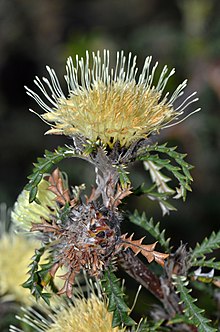Banksia kippistiana
| Banksia kippistiana | |
|---|---|

| |
| Scientific classification | |
| Kingdom: | Plantae |
| Clade: | Tracheophytes |
| Clade: | Angiosperms |
| Clade: | Eudicots |
| Order: | Proteales |
| Family: | Proteaceae |
| Genus: | Banksia |
| Subgenus: | Banksia subg. Banksia |
| Series: | Banksia ser. Dryandra |
| Species: | B. kippistiana |
| Binomial name | |
| Banksia kippistiana | |
| Synonyms[1] | |
| |
Banksia kippistiana is a species of shrub that is endemic to Western Australia. It has linear, pinnatifid leaves with ten to twenty lobes on each side, heads of up to eighty yellow and cream-coloured flowers, and elliptical follicles.
Description
Banksia kippistiana is a shrub that typically grows to a height of 1.5 m (4 ft 11 in) and may or may not form a lignotuber, depending on the variety. It has stems that are woolly-hairy when young. The leaves are linear, pinnatifid, 40–80 mm (1.6–3.1 in) long and 4–6 mm (0.16–0.24 in) wide on a petiole 1–3 mm (0.039–0.118 in) long. There are between ten and twenty triangular lobes on each side of the leaves. The flowers are arranged in heads of between fifty and eighty on the ends of branchlets with hairy involucral bracts 10–20 mm (0.39–0.79 in) long at the base of the head. The flowers are fragrant and have a pale yellow perianth 12–20 mm (0.47–0.79 in) long and a cream-coloured pistil 19–26 mm (0.75–1.02 in) long. Flowering occurs from August to November and the follicles are elliptical, 4–5 mm (0.16–0.20 in) long and 7–8 mm (0.28–0.31 in) wide.[2][3]
Taxonomy and naming
This species was first formally described in 1856 by Carl Meissner who gave it the name Dryandra kippistiana and published the description in de Candolle's Prodromus Systematis Naturalis Regni Vegetabilis from specimens collected by James Drummond in the Swan River Colony.[4][5] The specific epithet (kippistiana) commemorates Richard Kippist, librarian to the Linnean Society of London.[6][7]
In 1996, Alex George described two varieties of the species in the journal Nuytsia:
- Banksia kippistiana var. kippistiana[8] that does not form a lignotuber and has shorter flower parts and bracts than var. paenepeccata;[9]
- Banksia kippistiana var. paenepeccata[10] that forms a lignotuber and has a perianth 18–20 mm (0.71–0.79 in) long.[9]
In 2007 Austin Mast and Kevin Thiele transferred all dryandras to the genus Banksia and renamed this species Banksia kippistiana.[11][12] They also changed the genus names of the two varieties and the changes are accepted at the Australian Plant Census.[13][14]
Distribution and habitat
Banksia kippistiana grows in kwongan and occurs between Eneabba, Mount Lesueur and New Norcia, also in scattered locations to the south-eastern suburbs of Perth.
Conservation status
Banksia kippistiana is classified as "not threatened" by the Western Australian Government Department of Parks and Wildlife,[2] but var. paenepeccata is classified as "Priority Three"[15] meaning that it is poorly known and known from only a few locations but is not under imminent threat.[16]
References
- ^ a b "Banksia kippistiana". Australian Plant Census. Retrieved 9 May 2020.
- ^ a b "Banksia kippistiana". FloraBase. Western Australian Government Department of Biodiversity, Conservation and Attractions.
- ^ George, Alex S. (1999). Flora of Australia (PDF). Vol. 17B. Canberra: Australian Biological Resources Study, Canberra. p. 288. Retrieved 2 May 2020.
- ^ "Dryandra kippistiana". APNI. Retrieved 9 May 2020.
- ^ Meissner, Carl; de Candolle, Augustin P. (ed.) (1856). Prodromus Systematis Naturalis Vegetabilis. Paris: Sumptibus Victoris Masson. pp. 473–474. Retrieved 2 May 2020.
{{cite book}}:|first2=has generic name (help) - ^ Maiden, Joseph H. (1909). "Records of Australian Botanists". Journal of the West Australian Natural History Society. 2 (6): 31. Retrieved 10 May 2020.
- ^ "Minutes of the Meeting January 19th, 1883". Proceedings of the Linnean Society of London. 2: xxiv. 1880–81. Retrieved 10 May 2020.
- ^ "Dryandra kippistiana var. kippistiana". APNI. Retrieved 9 May 2020.
- ^ a b George, Alex (1996). "New taxa and a new infrageneric classification in Dryandra R.Br. (Proteaceae : Grevilleoideae)". Nuytsia. 10 (3): 348–349. Retrieved 9 May 2020.
- ^ "Dryandra kippistiana var. paenepeccata". APNI. Retrieved 9 May 2020.
- ^ Mast, Austin R.; Thiele, Kevin (2007). "The transfer of Dryandra R.Br. to Banksia L.f. (Proteaceae)". Australian Systematic Botany. 20 (1): 63–71. doi:10.1071/SB06016.
- ^ "Banksia kippistiana". APNI. Retrieved 9 May 2020.
- ^ "Banksia kippistiana var. kippistiana". Australian Plant Census. Retrieved 9 May 2020.
- ^ "Banksia kippistiana var. paenepeccata". Australian Plant Census. Retrieved 9 May 2020.
- ^ "Banksia kippistiana var. paenepeccata". FloraBase. Western Australian Government Department of Biodiversity, Conservation and Attractions.
- ^ "Conservation codes for Western Australian Flora and Fauna" (PDF). Government of Western Australia Department of Parks and Wildlife. Retrieved 9 May 2020.
- Cavanagh, Tony and Margaret Pieroni (2006). The Dryandras. Melbourne: Australian Plants Society (SGAP Victoria); Perth: Wildflower Society of Western Australia. ISBN 1-876473-54-1.
